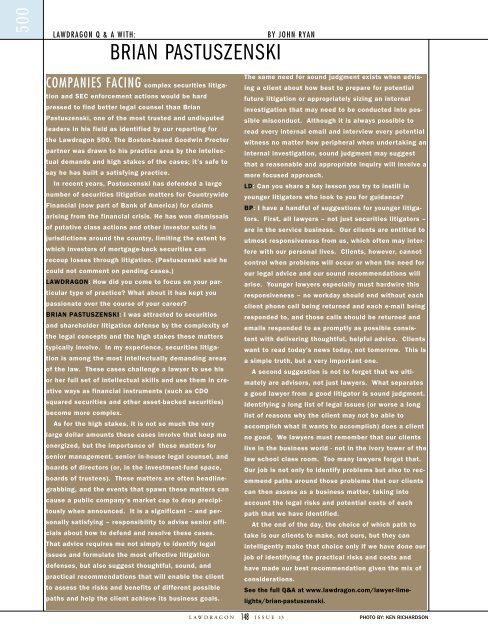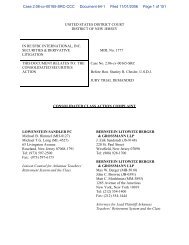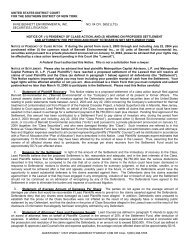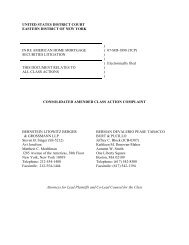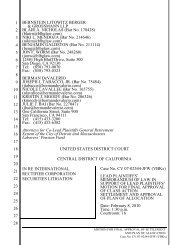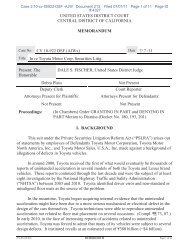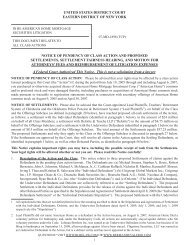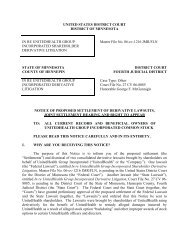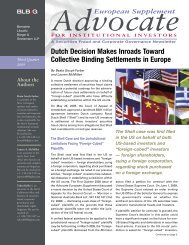to view the Lawdragon's - Bernstein Litowitz Berger & Grossmann LLP
to view the Lawdragon's - Bernstein Litowitz Berger & Grossmann LLP
to view the Lawdragon's - Bernstein Litowitz Berger & Grossmann LLP
Create successful ePaper yourself
Turn your PDF publications into a flip-book with our unique Google optimized e-Paper software.
500Lawdragon Q & A with:Brian PastuszenskibY John rYanCompanies facing complex securities litigationand SEC enforcement actions would be hardpressed <strong>to</strong> find better legal counsel than BrianPastuszenski, one of <strong>the</strong> most trusted and undisputedleaders in his field as identified by our reporting for<strong>the</strong> Lawdragon 500. The Bos<strong>to</strong>n-based Goodwin Procterpartner was drawn <strong>to</strong> his practice area by <strong>the</strong> intellectualdemands and high stakes of <strong>the</strong> cases; it’s safe <strong>to</strong>say he has built a satisfying practice.In recent years, Pastuszenski has defended a largenumber of securities litigation matters for CountrywideFinancial (now part of Bank of America) for claimsarising from <strong>the</strong> financial crisis. He has won dismissalsof putative class actions and o<strong>the</strong>r inves<strong>to</strong>r suits injurisdictions around <strong>the</strong> country, limiting <strong>the</strong> extent <strong>to</strong>which inves<strong>to</strong>rs of mortgage-back securities canrecoup losses through litigation. (Pastuszenski said hecould not comment on pending cases.)LAWDRAGon: How did you come <strong>to</strong> focus on your particulartype of practice? What about it has kept youpassionate over <strong>the</strong> course of your career?BRIAN PASTUSZENSKI: I was attracted <strong>to</strong> securitiesand shareholder litigation defense by <strong>the</strong> complexity of<strong>the</strong> legal concepts and <strong>the</strong> high stakes <strong>the</strong>se matterstypically involve. In my experience, securities litigationis among <strong>the</strong> most intellectually demanding areasof <strong>the</strong> law. These cases challenge a lawyer <strong>to</strong> use hisor her full set of intellectual skills and use <strong>the</strong>m in creativeways as financial instruments (such as CDOsquared securities and o<strong>the</strong>r asset-backed securities)become more complex.As for <strong>the</strong> high stakes, it is not so much <strong>the</strong> verylarge dollar amounts <strong>the</strong>se cases involve that keep meenergized, but <strong>the</strong> importance of <strong>the</strong>se matters forsenior management, senior in-house legal counsel, andboards of direc<strong>to</strong>rs (or, in <strong>the</strong> investment-fund space,boards of trustees). These matters are often headlinegrabbing,and <strong>the</strong> events that spawn <strong>the</strong>se matters cancause a public company’s market cap <strong>to</strong> drop precipi<strong>to</strong>uslywhen announced. It is a significant – and personallysatisfying – responsibility <strong>to</strong> advise senior officialsabout how <strong>to</strong> defend and resolve <strong>the</strong>se cases.That advice requires me not simply <strong>to</strong> identify legalissues and formulate <strong>the</strong> most effective litigationdefenses, but also suggest thoughtful, sound, andpractical recommendations that will enable <strong>the</strong> client<strong>to</strong> assess <strong>the</strong> risks and benefits of different possiblepaths and help <strong>the</strong> client achieve its business goals.The same need for sound judgment exists when advisinga client about how best <strong>to</strong> prepare for potentialfuture litigation or appropriately sizing an internalinvestigation that may need <strong>to</strong> be conducted in<strong>to</strong> possiblemisconduct. Although it is always possible <strong>to</strong>read every internal email and inter<strong>view</strong> every potentialwitness no matter how peripheral when undertaking aninternal investigation, sound judgment may suggestthat a reasonable and appropriate inquiry will involve amore focused approach.LD: Can you share a key lesson you try <strong>to</strong> instill inyounger litiga<strong>to</strong>rs who look <strong>to</strong> you for guidance?BP: I have a handful of suggestions for younger litiga<strong>to</strong>rs.First, all lawyers – not just securities litiga<strong>to</strong>rs –are in <strong>the</strong> service business. Our clients are entitled <strong>to</strong>utmost responsiveness from us, which often may interferewith our personal lives. Clients, however, cannotcontrol when problems will occur or when <strong>the</strong> need forour legal advice and our sound recommendations willarise. Younger lawyers especially must hardwire thisresponsiveness – no workday should end without eachclient phone call being returned and each e-mail beingresponded <strong>to</strong>, and those calls should be returned andemails responded <strong>to</strong> as promptly as possible consistentwith delivering thoughtful, helpful advice. Clientswant <strong>to</strong> read <strong>to</strong>day’s news <strong>to</strong>day, not <strong>to</strong>morrow. This isa simple truth, but a very important one.A second suggestion is not <strong>to</strong> forget that we ultimatelyare advisors, not just lawyers. What separatesa good lawyer from a good litiga<strong>to</strong>r is sound judgment.Identifying a long list of legal issues (or worse a longlist of reasons why <strong>the</strong> client may not be able <strong>to</strong>accomplish what it wants <strong>to</strong> accomplish) does a clientno good. We lawyers must remember that our clientslive in <strong>the</strong> business world - not in <strong>the</strong> ivory <strong>to</strong>wer of <strong>the</strong>law school class room. Too many lawyers forget that.Our job is not only <strong>to</strong> identify problems but also <strong>to</strong> recommendpaths around those problems that our clientscan <strong>the</strong>n assess as a business matter, taking in<strong>to</strong>account <strong>the</strong> legal risks and potential costs of eachpath that we have identified.At <strong>the</strong> end of <strong>the</strong> day, <strong>the</strong> choice of which path <strong>to</strong>take is our clients <strong>to</strong> make, not ours, but <strong>the</strong>y canintelligently make that choice only if we have done ourjob of identifying <strong>the</strong> practical risks and costs andhave made our best recommendation given <strong>the</strong> mix ofconsiderations.See <strong>the</strong> full Q&A at www.lawdragon.com/lawyer-limelights/brian-pastuszenski.L A W D R A G O N 148 I s s u e 13Pho<strong>to</strong> by: Ken Richardson


